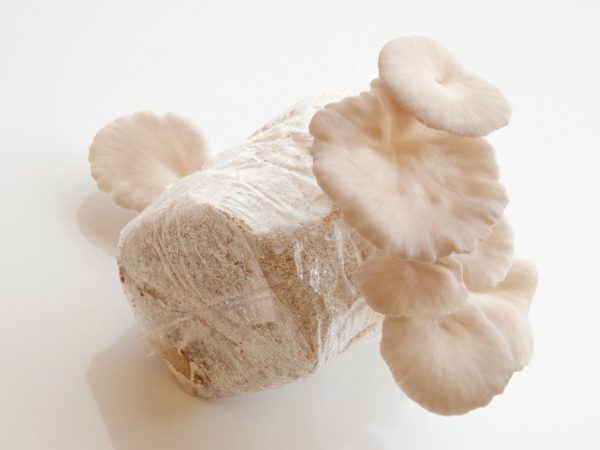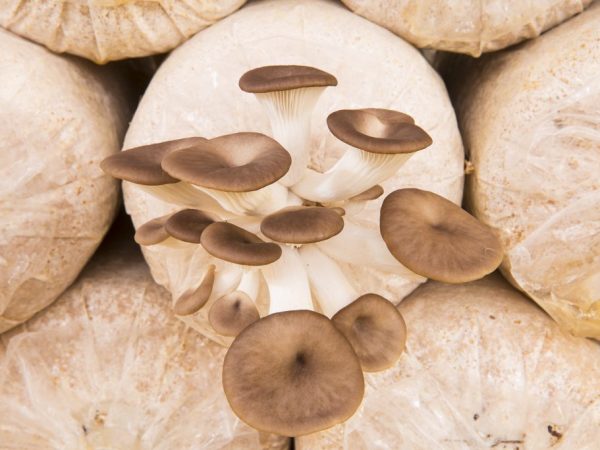Growing oyster mushrooms in an apartment
Oyster mushroom, or oyster, is a type of edible mushroom that grows in the forests of the temperate climatic zone. Growing oyster mushrooms in an apartment has several features. Adhering to the established rules of care, you can enjoy the refined taste of this delicacy all year round.

Growing oyster mushrooms in an apartment
Types of growing oyster mushrooms
You can grow oyster mushrooms in an apartment in the following ways:
- Growing in natural conditions: this is the minimum cost (one might say "budget") option. You just need to choose a suitable substrate and provide watering. The disadvantages of this method include a long wait for the ripening of fruit bodies and low yield.
- Growing in artificial conditions: this is a much more laborious and costly method. It is necessary to equip a special room with controlled lighting, temperature and humidity.
After choosing the breeding method, they are determined with the place where the necessary equipment is installed and the mycelium is acquired.
Seat selection
It is advisable to grow mushrooms at home under certain conditions:
- Lack of pests and diseases.
- Maintaining the temperature at + 15 °… + 25 ° C.
- Humidity is about 85%.
- Good ventilation.
It is impossible to grow mushrooms on a windowsill in a tub of soil. The best option would be a separate room, storage room or glazed balcony.
Choice of substrate
After choosing a room and carrying out all measures for its improvement, a substrate is chosen.
It is better to grow oyster mushrooms on artificial soil. For this, plant components are used:
- dried spikelets of cereals;
- hulls from sunflower seeds and pumpkin;
- sawdust or shavings of hardwood trees;
- ground corn cobs and leaves.
Ready-made mixtures are also often used. The main thing in choosing a substrate is the presence of cellulose, an increased nitrogen content, as well as the absence of mold and other pests.
Soil preparation
After selection, the substrate is prepared for planting. There are several stages of preparation:
- sorting material: check for the absence of rot and mold;
- heat treatment: rinsing in hot water and subsequent steam treatment;
- drying: the raw material is dried by calcining;
- preparation of the substrate: grinding and mixing.
The finished substrate is placed in bags and formed in the form of blocks, and then placed in a pre-prepared room.
Landing
After carrying out all the preparatory work, it is time to prepare the mushroom itself for planting. In most cases, they use its vegetative state - mycelium. Preparation includes:
- Adaptation to living conditions: one day is enough for this. Regular ventilation should be established.
- Transferring the crushed mycelium to the equipped room: it is important not to open the bags before this: the mushrooms must get used to the temperature. The most suitable is considered to be 20 ° C.
- Compliance with sterility: this is an extremely important condition for the further placement of the mycelium in containers. It is better to carry out the process in several stages in different rooms.

It is important to maintain optimal temperature conditions
After that, a mixture is formed from the substrate and the mycelium of oyster mushrooms in a ratio of 19: 1.
Irina Selyutina (Biologist):
Fill plastic bags in layers:
- substrate layer about 5-6 cm thick;
- mycelium layer 0.5 cm thick.
Attention! The last layer must necessarily be the substrate.
Then the bag is tied and holes are made. The first few days (about 3-4), the substrate inside the bags will heat up. This is normal. The most important thing is to keep the temperature at a level not higher than + 30 ℃. It can be reduced to this level with the help of a fan, which is directed directly to the blocks. At this time, the mycelium does not need additional lighting. In about 10-12 days, the mycelium will fill the block and it will look like a dense white homogeneous mass with a mushroom smell. In order to maintain a high level of humidity at this stage of development, you will have to spray the room (walls and floor) with water in such a way as to exclude any accidental contact with the substrate. If the optimal conditions are met, then very soon you will see the rudiments of fruit bodies in the cuts.
By the way. It is better to twist mature mushrooms out of the substrate, rather than cut them off.
The finished composition is laid out in packages, the total capacity of which is 7-10 kg. On one side, shallow oblique cuts 3-5 cm long are applied. This will ensure air circulation and watering.
Care
The most important thing when caring for oyster mushrooms is to adhere to a certain temperature regime.
It is also undesirable to ventilate the room during germination. Carbon dioxide, which is released during the maturation of the mycelium, creates the necessary atmosphere and maintains humidity at a vital, optimal level.
The incubation period on average takes about 16-23 days. After that, the bags are placed vertically and the ripening of the crop begins.
At this stage, the main features of care are:
- maintaining the temperature at a level not lower than + 10 ° ... + 20 ° C;
- humidity up to 95%;
- light intensity - 5 W per square meter.
Watering
Oyster mushrooms require regular watering once a day using the irrigation system. You can also use a spray bottle, however, in this case, the number of waterings rises to 2-3 per day. Use only room temperature water.
Top dressing
With the correct selection of the substrate, it is permissible to grow oyster mushrooms without additional feeding. However, nutritional supplements are used to increase yields. Basically, they are of a proteinaceous or proteinaceous-fatty nature. They are characterized by a low level of cellulose, but an increased nitrogen content.
Top dressing is carried out together with watering with a solution of nitrogen fertilizers or using special granules. Granules contain flour, clover hay, grass, malt.
However, feeding is carried out no more than once a week. The optimal solution would be a combination of 1 kg of fertilizer per 10 liters of water.
Prevention and treatment of diseases
The biggest danger for the successful breeding of oyster mushrooms in an apartment is the appearance of mold and rot. Due to the high humidity of the room where they are bred, even the slightest penetration of harmful organisms leads to sad consequences.
Mold prevention
It is almost impossible to fight against the appearance of mold already at the time of harvest ripening, therefore, preventive measures are usually taken. The main ways are:
- Preliminary renovation of the premises. Walls should be painted with water-repellent exterior paint, the floor should be cemented, windows and doors should be free of cracks and crevices.
- Before planting, the entire space of the room is treated with a disinfectant.
- The soil, bags and mycelium are heat treated.
- When forming blocks, maintain a sterile environment, use gloves and a respirator.
Prevention of the appearance of rot
Rot, or rather, the parasitic fungus Botrytis, poses a serious threat when growing oyster mushrooms. The presence of even a small amount of spores or mycelium of this species leads to the loss of the entire crop.
There is no way to completely remove malicious spores. The main prevention of the appearance of rot is a thorough preliminary treatment of the substrate and compliance with all sanitary rules when growing mushrooms.
Conclusion
It's easy to grow oyster mushrooms in an apartment, you just need to want to. If you follow the rules for breeding this crop, the results will not be long in coming. These are the most convenient mushrooms for home cultivation. They combine low cost of equipment, ease of maintenance and delicate taste.


